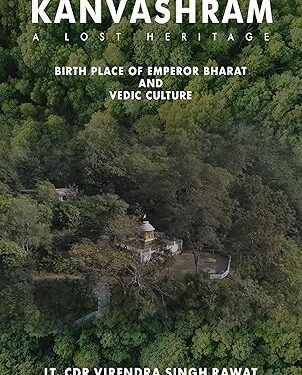
Kanvashram: India is a land of layered histories, sacred geographies, and timeless civilisational memories. Yet, in the noise of modernity, many ancient sites that once shaped the soul of this nation have slipped into obscurity. Kanvashram – A Lost Heritage, Birth Place of Emperor Bharat and Vedic Culture is a powerful attempt to bring one such forgotten legacy back into public consciousness. Written by Lt Cdr. Virender Singh Rawat (Retd), the book is a compelling blend of history, cultural research, personal passion, and national remembrance.
At its heart, this work is about Kanvashram—an ancient Vedic heritage site that once held extraordinary influence during the era when the Rig Veda was composed. Situated along the banks of the River Malini in the Shivalik ranges of present-day Uttarakhand, Kanvashram was a thriving seat of knowledge, spirituality, and cultural evolution. It was here that legendary Rishi Kanv resided with his disciples, and it was here that Emperor Bharat, son of King Dushyant and Shakuntala, was born—the very emperor after whom our nation is named, Bharat Varsh.
Despite this monumental significance, the author reminds us that Kanvashram gradually disappeared from mainstream memory. What was once a luminous beacon of the Vedic world was eventually engulfed by dense forests, neglected by society, and overshadowed by changing political narratives and foreign invasions. By the 20th century, very few people even remembered its existence.
A Chronicle of Civilisation—Not Just a Site
Rawat’s research does more than excavate a forgotten landmark. He links the story of Kanvashram with the story of India itself. The book traces the journey of ancient migrants who abandoned their homeland on the drying banks of the River Saraswati and settled along the River Malini. Through them, a new cultural ecosystem was born—rooted in Vedic wisdom, self-sustaining communities, and intellectual flowering.
This is where the book succeeds most: it shows how civilisation is not just built on monuments, but on memory, continuity, and living culture. Kanvashram becomes a symbol of what Bharat once was—enlightened, curious, resilient, and deeply rooted in dharma.
Narrative Style and Research
The author writes with a rare combination of emotional intensity and disciplined research. His naval background gives the narrative a structured clarity, while his devotion to heritage preservation injects sincerity and depth. The storytelling is vivid yet factual, allowing readers to visualise the ashram, its people, and its aura.
The book avoids being a dry historical account. Instead, it reads like a civilisational journey, moving through:
-
The intellectual brilliance of Vedic scholars
-
The political and cultural footprint of Kanvashram
-
The rise and decline of the site over centuries
-
The erasure of indigenous heritage under foreign influence
-
The urgent need to reclaim historical identity today
Why This Book Matters Today
In an age where history is often debated, diluted, or distorted, Kanvashram – A Lost Heritage is a reminder to return to authentic roots. It raises a critical question: How can a nation truly progress if it forgets its own origin?
The book makes you reflect on:
-
How easily heritage can disappear without documentation and awareness
-
How modern India must protect, restore, and honour its ancient sites
-
How cultural pride is built through truth, not borrowed narratives
For readers interested in Indian history, Vedic culture, archaeology, or civilisational studies, this book offers both knowledge and perspective. For the general reader, it offers a gripping rediscovery of identity.
Verdict
Lt Cdr. Rawat’s work is more than a book—it is a tribute, a wake-up call, and an act of preservation. It restores Kanvashram to its rightful place in India’s civilisational story and urges the nation to remember what should never have been forgotten.
Kanvashram – A Lost Heritage is a must-read for anyone who believes that history is not just about the past—it is about who we are.















